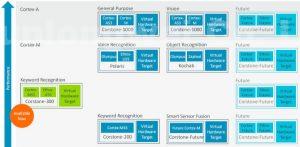Arm offers cloud-based virtual Cortex-M hardware, and a security framework
At the same time, it has created a standards-based model for creating secure IoT devices built around Cortex-M processors.
Cloud-based SoC emulation for Cortex-M
 Dubbed ‘Arm Virtual Hardware’, the cloud-based simulators are aimed at software developers, OEMs and service providers, and will be available for the specific SoC configurations already offered in the company’s ‘Corstone’ programme of pre-verified pre-integrated IP blocks (example right).
Dubbed ‘Arm Virtual Hardware’, the cloud-based simulators are aimed at software developers, OEMs and service providers, and will be available for the specific SoC configurations already offered in the company’s ‘Corstone’ programme of pre-verified pre-integrated IP blocks (example right).
“With accurate models of Arm-based SoCs providing mechanisms for simulating memory, peripherals and more, development and testing of software is now possible before silicon availability,” according to Arm. It “brings modern agile software development methodologies like CI/CD [continuous integration – continuous deployment], DevOps and MLOps to IoT and embedded platforms, without having to invest in complex hardware farms”.
First to be released will be a virtual Corstone 300, which includes a Cortex-M55 CPU, an Ethos-U55 neural processor, a random number generator, a flash controller (single or dual port), AHB5 TrustZone and power control amongst its components.
“Specifically, for the Ethos-U55 within Corstone-300,” Arm told Electronics Weekly, “the Arm Virtual Hardware model provides cycle-approximate information on its execution which can be used to estimate how fast a particular neural network would run on the real hardware.”
Arm Virtual Hardware is free while still in beta, “however cloud costs may be incurred when running it in a cloud infrastructure such as AWS EC2,” said the company. “Arm has partnered with AWS to provide more than 100 hours worth of free AWS EC2 credits for the first 1,000 users who register on the Arm website.”
IoT security framework
Inspired by ‘Project Cassini’ for the Cortex-A software eco-system, Arm has defined ‘Project Centauri’ for the Cortex-M eco-system – a curated set of device and platform standards, along with reference implementations for device boot, security and cloud integration.
Project Centauri APIs include support for PSA Certified security firmware and hardware blocks, and support for Open-CMSIS-CDI – the latter a standard cloud-to-device specification that helps accommodate different clouds and different real-time operating systems.
Taking all three together: Corestone, the web-based Corestone Virtual Hardware and Project Centauri, Arm is wrapping them in a single brand: the ambitiously-named ‘Total Solutions for IoT’.
 Total Solutions for IoT roadmap (Polaris and Kochab are future Corstones, Olympus is a future Cortex-M CPU and Zaphod a future Ethos neural processor.)
Total Solutions for IoT roadmap (Polaris and Kochab are future Corstones, Olympus is a future Cortex-M CPU and Zaphod a future Ethos neural processor.)
“Arm Total Solutions for IoT changes the way we’re delivering key technology to the entire ecosystem and demonstrates our significant and ongoing investment in the software,” said its v-p if IoT Mohamed Awad.
The first Total Solution is aimed at general-purpose computation and machine learning – including keyword recognition – and is based on the Corstone-300 integrated intellectual property blocks mentioned above.